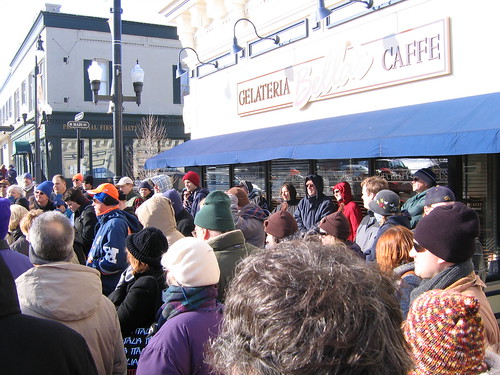Groundhog Days in Woodstock Part 2

by Arthur
Posted on Sunday, February 1st, 2009 at 11:11 am CET
(continued from part 1) So we were waiting outside the Opera House for the tour of the filming sites in Woodstock and at 1:25pm we were still the only ones there. A police officer of the WPD confirmed that we were in the right place for the tour, but where was everybody? Then all of a sudden people poured out of the Opera House, where they had been for a Chili Cookoff, as they do in Punxutawney. There were about 50 people in the tour, which was led by Bob Hutchins, the location manager of Groundhog Day. He gave us a great insight in the filming of the movie and all the different filming locations in Woodstock. First off he explained how they chose the town of Woodstock.
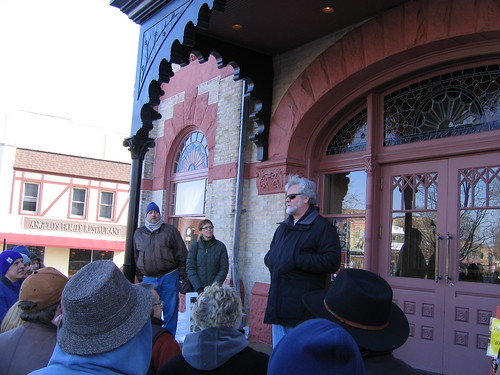
Hutchins used to work for the Illinois Film Board in 1992 (he currently lives in Austin Texas, and still comes to Woodstock every February to give these tours) and had been asked by director Harold Ramis to find a town near Chicago that they could use for the filming of Groundhog Day. It had to be close to Chicago as that is where Ramis and Bill Murray lived at the time. They drove around for several weeks looking for a Main Street town like Punxsutawney in Pennsylvania, the original town where the movie is supposed to take place. Woodstock doesn’t have a Main Street, so they were not considering it.
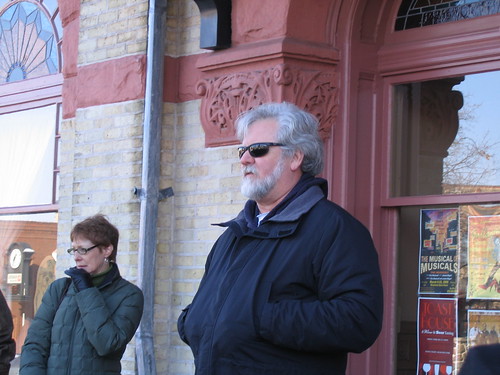
Until they came across the town of Baraboo, Wisconsin, which has a beautiful historic town square. Ramis started to like the idea of a square better than a main street, but wanted something closer to Chicago, so he asked Hutchins if he knew of a town like Baraboo with a nice town square. He had in fact worked in Woodstock once for Planes, Traines & Automobiles with Steve Martin. The next day they drove to Woodstock, climbed to the top of the Opera House to get a good view of the square, and they liked it immediately.
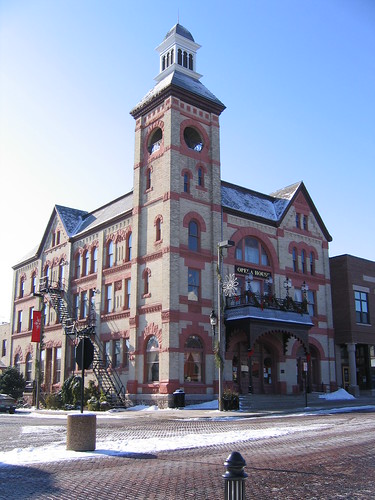
Opera HouseIn the movie Bill Murray jumps off this tower one of the many times he tries to kill himself, as in the beginning of the following clip. Hutchins told about the huge air mattress they set up in the street and the local stuntman from Woodstock who did it right in one take.
At that time they were still only planning to film a few scenes on the historic square and build Gobbler’s Knob, where the groundhog prognostication takes place, in a park somewhere else. In the real Punxsutawney the event also takes place in a park outside of town. They were going to be filming in town for only a week and then move out, which is what the businesses on the square had originally agreed to. But when Hutchins and Ramis were walking around Woodstock Square they suddenly realized that Gobbler’s Knob had to be right there, in the middle of the square. It was all perfect. The square became a symbol for the cage that Phil was in, as he was unable to leave the town. All of a sudden they had to tell the town and the businesses on the square that they were going to stay for 6 weeks instead of just one. And this news was not well received.
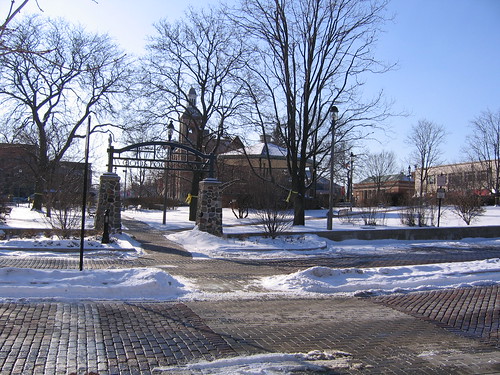
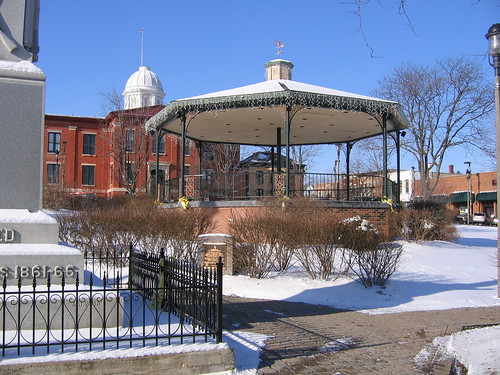
Location of Gobbler’s KnobThe filming crew ended up filming in the Illinois town for 6 weeks from March to May 1993, which is an unusually long time for a movie to be in one location. The mayor and chamber of commerce were very helpful in accommodating the crew, but the downtown shops and businesses were not. In fact, a total of 23 businesses were against the Columbia Pictures filmmakers to take over the town and they tried to block the film from being shot in Woodstock. There were town hall meetings where the business owners wore “23” buttons and made their case. As Hutchins explained what exactly they were about to do, more and more shops dropped out of the resistance. At one meeting they had to change their buttons to “14” and in the end only 3 businesses were left that were against it, but filming went ahead.

The crew transformed the town square into the set for Groundhog Day. The film crew put in a huge pile of sand to make Gobbler’s Knob in the middle of the square, which they later took out. The thousands of people that ran around the park for 6 weeks really trampled the grass, so when filming was completed they resodded the whole park with new grass and they even put in nice walking paths as a gift to the city.
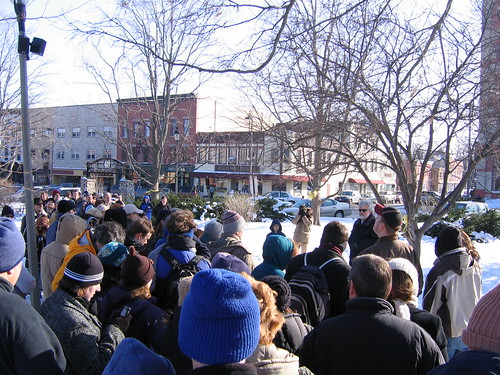
Every year a new plaque is revealed and this year’s new plaque was for Gobbler’s Knob. It was revealed during this tour and will be affixed to one of the trees or in the ground.
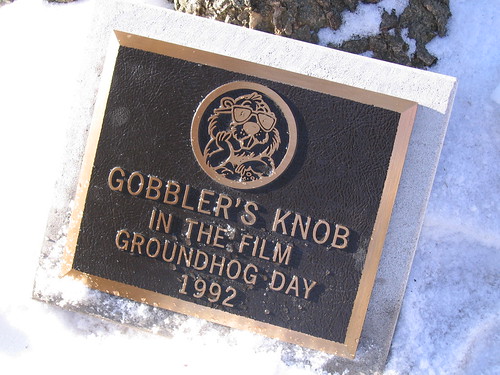
Then we all walked over to the other side of the square, the location of Tip-Top Cafe, the puddle and the sidewalk where Phil Connors kept running into Ned Ryerson. The corner is now called Ned’s Corner and there’s a plaque on the wall commemorating the spot. Here’s a clip of this place:
After meeting Ned, Phil several times steps off the curb into a puddle. Hutchins explained that every morning the crew would take out some of the bricks in the road, dig a hole and fill it with dark water and styrofoam that looked like floating ice. And in the evening they put it all back to make sure people walking there wouldn’t break there ankle stepping into the hole. It was very cold those days so they wrapped Bill Murray’s foot in Saran wrap and neoprene to protect his leg from the freezing water. They did the shot many times, and every time he had to be unwrapped, dried off with hair blowers and put on dry pants.
Here’s a clip from someone else who filmed Stephen Tobolowsky (Ned Ryerson) talking about this in Woodstock once, probably during Groundhog Days in 2004 when Stephen visited Woodstock.
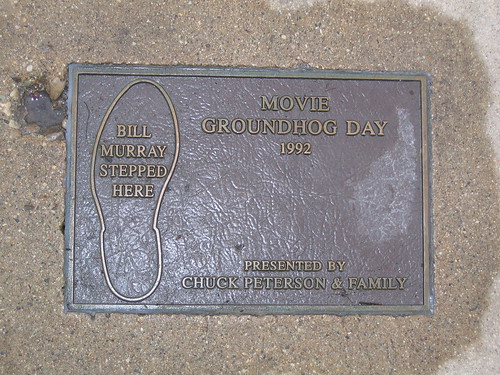
Hutchins got hundreds of contracts with all the businesses on the square to be allowed to change their facade and use their roofs for filming. They put up huge lights on all the roofs around the square and changed all the store names, except for Woodstock Jeweler’s, which can prominently be seen in the movie.
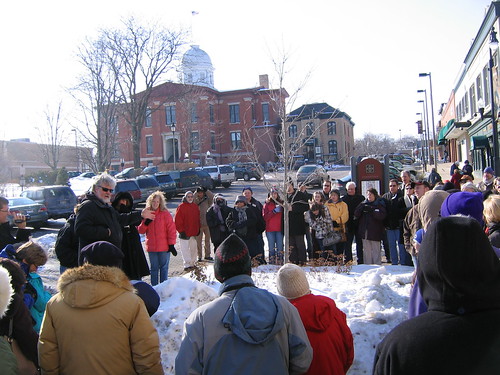
After this we all walked north toward the train station and passed the movie theater. Across from the theater is a small alley called Old Man’s Alley. This is the place where Phil tried to resuscitate the old man, at the bottom of these steps:
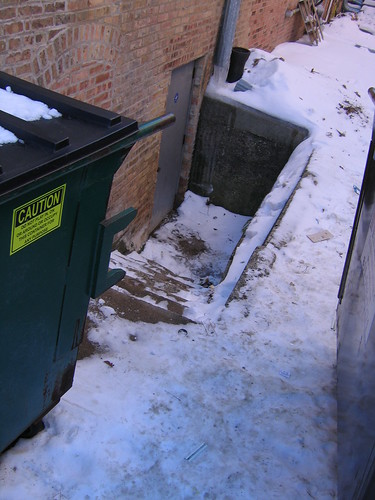
At the train station Hutchins explained that Metra only allowed them drive cars on the tracks for 5 minutes. For the rest of the scene where Phil and the two drunks drive on the tracks followed by a police car was shot at the Illinois Railway Museum in Union where they were able to rent a piece of unused track for a while.
Across from the street is the bowling alley where the bar scene takes place.
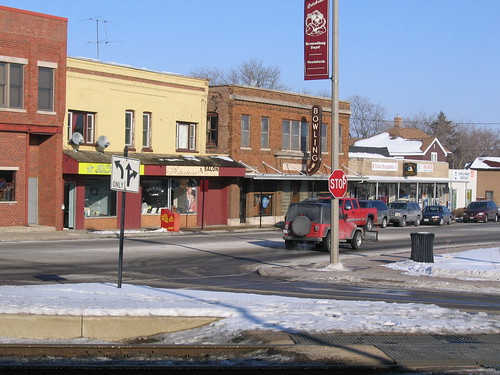
They had originally written two different scenes, a long bowling scene that was cut and the scene at the bar. But the bowling alley had such a nice round bar that they decided to rewrite the scenes into one.
Near the bowling alley is the train station and several scenes were shot in this area, but Hutchins explained that they went through great lengths not to show any of the train station in the movie. If the audience knew that there was a train station then Phil could have taken the train to escape the town that he was trapped in.
Last stop on the tour was the Cherry Street Inn, where Phil Connors kept waking up every morning at 6:00. It is a beautiful Victorian house at the end of S Madison Street. Hutchins told us that the owner of the house allowed them to place cameras inside the windows to shoot the street, but all of the interior scenes were shot on a set in a warehouse in Cary. They redid the panels on the side of the house and allowed the owner to pick out the color. Unfortunately they had to take out a large pine tree from the front yard, which Hutchins hated to do, but it was obscuring half the house. The family was compensated for the use of their home and the loss of the tree.

Cherry Street InnThe house next to the Inn, shown in the picture here, was run down and the crew fixed it up for the film.
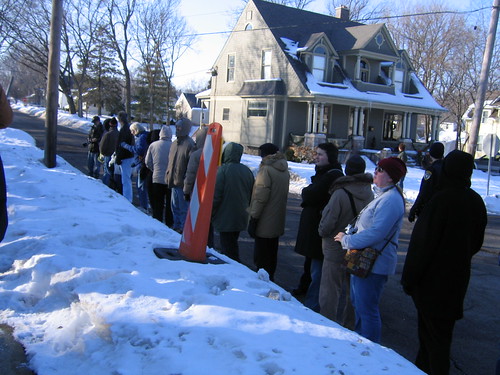
Hutchins told us that for the final scene in the movie they needed the street to be covered in snow. It’s the morning on February 3rd when Phil wakes up and the blizzard has passed. The only natural snow in the move is in this scene, and the day before the snowfall the crew told all the residents in the street that the next morning would be the day. They were asked to not plow their driveways or leave their homes until they were done. They got 8 inches that morning and were able do the scene beautifully. If it had not snowed during the time they were there then they would have had to cover the whole street in fake snow. The following picture shows the street in front of the Cherry Street Inn, with all the people in the tour walking toward the house.
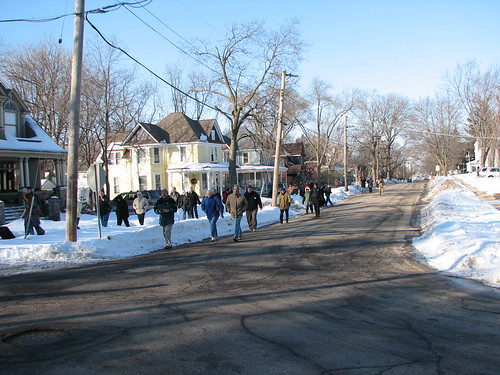
The 114-year-old Victorian-style house was never actually used for guests, but the house was recently purchased by someone who plans to turn it into a real bed and breakfast!
Tomorrow morning we will try to make it to the actual prognostication of the groundhog at 7:07 in Woodstock. To be continued. 😉
(continued from part 1) So we were waiting outside the Opera House for the tour of the filming sites in Woodstock and at 1:25pm we were still the only ones there. A police officer of the WPD confirmed that we were in the right place for the tour, but where was everybody? Then all of a sudden people poured out of the Opera House, where they had been for a Chili Cookoff, as they do in Punxutawney. There were about 50 people in the tour, which was led by Bob Hutchins, the location manager of Groundhog Day. He gave us a great insight in the filming of the movie and all the different filming locations in Woodstock. First off he explained how they chose the town of Woodstock.

Hutchins used to work for the Illinois Film Board in 1992 (he currently lives in Austin Texas, and still comes to Woodstock every February to give these tours) and had been asked by director Harold Ramis to find a town near Chicago that they could use for the filming of Groundhog Day. It had to be close to Chicago as that is where Ramis and Bill Murray lived at the time. They drove around for several weeks looking for a Main Street town like Punxsutawney in Pennsylvania, the original town where the movie is supposed to take place. Woodstock doesn’t have a Main Street, so they were not considering it.

Until they came across the town of Baraboo, Wisconsin, which has a beautiful historic town square. Ramis started to like the idea of a square better than a main street, but wanted something closer to Chicago, so he asked Hutchins if he knew of a town like Baraboo with a nice town square. He had in fact worked in Woodstock once for Planes, Traines & Automobiles with Steve Martin. The next day they drove to Woodstock, climbed to the top of the Opera House to get a good view of the square, and they liked it immediately.

Opera House
In the movie Bill Murray jumps off this tower one of the many times he tries to kill himself, as in the beginning of the following clip. Hutchins told about the huge air mattress they set up in the street and the local stuntman from Woodstock who did it right in one take.
At that time they were still only planning to film a few scenes on the historic square and build Gobbler’s Knob, where the groundhog prognostication takes place, in a park somewhere else. In the real Punxsutawney the event also takes place in a park outside of town. They were going to be filming in town for only a week and then move out, which is what the businesses on the square had originally agreed to. But when Hutchins and Ramis were walking around Woodstock Square they suddenly realized that Gobbler’s Knob had to be right there, in the middle of the square. It was all perfect. The square became a symbol for the cage that Phil was in, as he was unable to leave the town. All of a sudden they had to tell the town and the businesses on the square that they were going to stay for 6 weeks instead of just one. And this news was not well received.


Location of Gobbler’s Knob
The filming crew ended up filming in the Illinois town for 6 weeks from March to May 1993, which is an unusually long time for a movie to be in one location. The mayor and chamber of commerce were very helpful in accommodating the crew, but the downtown shops and businesses were not. In fact, a total of 23 businesses were against the Columbia Pictures filmmakers to take over the town and they tried to block the film from being shot in Woodstock. There were town hall meetings where the business owners wore “23” buttons and made their case. As Hutchins explained what exactly they were about to do, more and more shops dropped out of the resistance. At one meeting they had to change their buttons to “14” and in the end only 3 businesses were left that were against it, but filming went ahead.

The crew transformed the town square into the set for Groundhog Day. The film crew put in a huge pile of sand to make Gobbler’s Knob in the middle of the square, which they later took out. The thousands of people that ran around the park for 6 weeks really trampled the grass, so when filming was completed they resodded the whole park with new grass and they even put in nice walking paths as a gift to the city.

Every year a new plaque is revealed and this year’s new plaque was for Gobbler’s Knob. It was revealed during this tour and will be affixed to one of the trees or in the ground.

Then we all walked over to the other side of the square, the location of Tip-Top Cafe, the puddle and the sidewalk where Phil Connors kept running into Ned Ryerson. The corner is now called Ned’s Corner and there’s a plaque on the wall commemorating the spot. Here’s a clip of this place:
After meeting Ned, Phil several times steps off the curb into a puddle. Hutchins explained that every morning the crew would take out some of the bricks in the road, dig a hole and fill it with dark water and styrofoam that looked like floating ice. And in the evening they put it all back to make sure people walking there wouldn’t break there ankle stepping into the hole. It was very cold those days so they wrapped Bill Murray’s foot in Saran wrap and neoprene to protect his leg from the freezing water. They did the shot many times, and every time he had to be unwrapped, dried off with hair blowers and put on dry pants.
Here’s a clip from someone else who filmed Stephen Tobolowsky (Ned Ryerson) talking about this in Woodstock once, probably during Groundhog Days in 2004 when Stephen visited Woodstock.

Hutchins got hundreds of contracts with all the businesses on the square to be allowed to change their facade and use their roofs for filming. They put up huge lights on all the roofs around the square and changed all the store names, except for Woodstock Jeweler’s, which can prominently be seen in the movie.

After this we all walked north toward the train station and passed the movie theater. Across from the theater is a small alley called Old Man’s Alley. This is the place where Phil tried to resuscitate the old man, at the bottom of these steps:

At the train station Hutchins explained that Metra only allowed them drive cars on the tracks for 5 minutes. For the rest of the scene where Phil and the two drunks drive on the tracks followed by a police car was shot at the Illinois Railway Museum in Union where they were able to rent a piece of unused track for a while.
Across from the street is the bowling alley where the bar scene takes place.

They had originally written two different scenes, a long bowling scene that was cut and the scene at the bar. But the bowling alley had such a nice round bar that they decided to rewrite the scenes into one.
Near the bowling alley is the train station and several scenes were shot in this area, but Hutchins explained that they went through great lengths not to show any of the train station in the movie. If the audience knew that there was a train station then Phil could have taken the train to escape the town that he was trapped in.
Last stop on the tour was the Cherry Street Inn, where Phil Connors kept waking up every morning at 6:00. It is a beautiful Victorian house at the end of S Madison Street. Hutchins told us that the owner of the house allowed them to place cameras inside the windows to shoot the street, but all of the interior scenes were shot on a set in a warehouse in Cary. They redid the panels on the side of the house and allowed the owner to pick out the color. Unfortunately they had to take out a large pine tree from the front yard, which Hutchins hated to do, but it was obscuring half the house. The family was compensated for the use of their home and the loss of the tree.

Cherry Street Inn
The house next to the Inn, shown in the picture here, was run down and the crew fixed it up for the film.

Hutchins told us that for the final scene in the movie they needed the street to be covered in snow. It’s the morning on February 3rd when Phil wakes up and the blizzard has passed. The only natural snow in the move is in this scene, and the day before the snowfall the crew told all the residents in the street that the next morning would be the day. They were asked to not plow their driveways or leave their homes until they were done. They got 8 inches that morning and were able do the scene beautifully. If it had not snowed during the time they were there then they would have had to cover the whole street in fake snow. The following picture shows the street in front of the Cherry Street Inn, with all the people in the tour walking toward the house.

The 114-year-old Victorian-style house was never actually used for guests, but the house was recently purchased by someone who plans to turn it into a real bed and breakfast!
Tomorrow morning we will try to make it to the actual prognostication of the groundhog at 7:07 in Woodstock. To be continued. 😉


